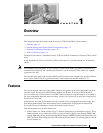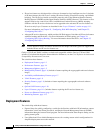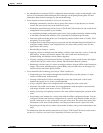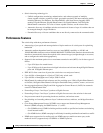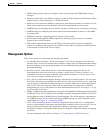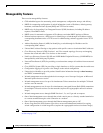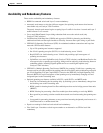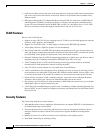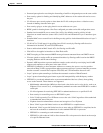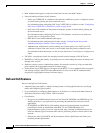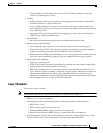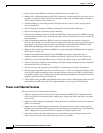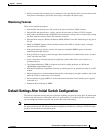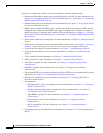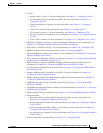
1-8
Catalyst 3750-E and 3560-E Switch Software Configuration Guide
OL-9775-02
Chapter 1 Overview
Features
• Link-state tracking to mirror the state of the ports that carry upstream traffic from connected hosts
and servers and to allow the failover of the server traffic to an operational link on another Cisco
Ethernet switch
• RPS support through the Cisco Redundant Power System 2300, also referred to as RPS 2300, for
enhancing power reliability, including the ability to configure and manage the redundant power
system. For more information about the RPS 2300, see the Cisco Redundant Power System 2300
Hardware Installation Guide that shipped with the device and also on Cisco.com.
VLAN Features
These are the VLAN features:
• Support for up to 1005 VLANs for assigning users to VLANs associated with appropriate network
resources, traffic patterns, and bandwidth
• Support for VLAN IDs in the 1 to 4094 range as allowed by the IEEE 802.1Q standard
• VLAN Query Protocol (VQP) for dynamic VLAN membership
• Inter-Switch Link (ISL) and IEEE 802.1Q trunking encapsulation on all ports for network moves,
adds, and changes; management and control of broadcast and multicast traffic; and network security
by establishing VLAN groups for high-security users and network resources
• Dynamic Trunking Protocol (DTP) for negotiating trunking on a link between two devices and for
negotiating the type of trunking encapsulation (IEEE 802.1Q or ISL) to be used
• VLAN Trunking Protocol (VTP) and VTP pruning for reducing network traffic by restricting
flooded traffic to links destined for stations receiving the traffic
• Voice VLAN for creating subnets for voice traffic from Cisco IP Phones
• VLAN 1 minimization for reducing the risk of spanning-tree loops or storms by allowing VLAN 1
to be disabled on any individual VLAN trunk link. With this feature enabled, no user traffic is sent
or received on the trunk. The switch CPU continues to send and receive control protocol frames.
• Private VLANs to address VLAN scalability problems, to provide a more controlled IP address
allocation, and to allow Layer 2 ports to be isolated from other ports on the switch
• Port security on a PVLAN host to limit the number of MAC addresses learned on a port, or define
which MAC addresses may be learned on a port
• VLAN Flex Link Load Balancing to provide Layer 2 redundancy without requiring Spanning Tree
Protocol (STP). A pair of interfaces configured as primary and backup links can load balance traffic
based on VLAN.
Security Features
The switch ships with these security features:
• Web authentication to allow a supplicant (client) that does not support IEEE 802.1x functionality to
be authenticated using a web browser.
• Password-protected access (read-only and read-write access) to management interfaces (device
manager, Network Assistant, and the CLI) for protection against unauthorized configuration
changes
• Multilevel security for a choice of security level, notification, and resulting actions
• Static MAC addressing for ensuring security




